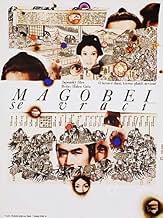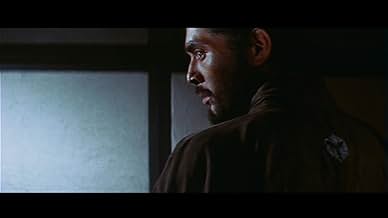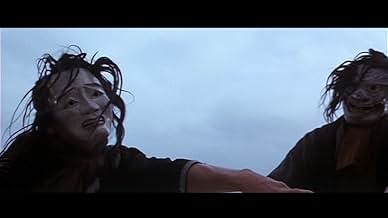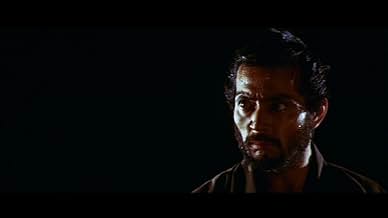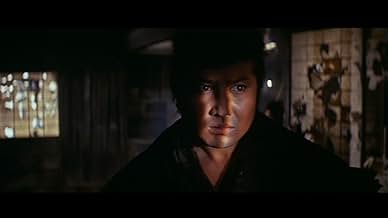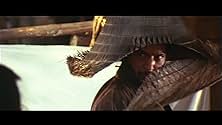IMDb RATING
7.6/10
2.8K
YOUR RATING
A guilt-haunted samurai warrior attempts to prevent a massacre from taking place.A guilt-haunted samurai warrior attempts to prevent a massacre from taking place.A guilt-haunted samurai warrior attempts to prevent a massacre from taking place.
- Awards
- 2 wins & 1 nomination total
- Director
- Writers
- All cast & crew
- Production, box office & more at IMDbPro
Featured reviews
"Goyokin" is passionate, poetic, beautiful, colorful, thrilling, and brilliantly-filmed. It would be an understatement to say that "Goyokin" is one of the best-looking films I've seen in a long time. Hideo Gosha is one of the most under-appreciated Japanese directors and I say this purely on the strength of this one film because it is a true masterpiece.
"Goyokin" has a sense of theatricality about it that fits better than even many of Kurosawa's films. "Rashomon" for instance features performances completely unsuitable for the film's general mood (in my opinion), but in "Goyokin" the nature of the film fits perfectly with the mood and atmosphere Gosha creates. It's almost operatic in many ways, most noticeably so in the exquisitely-filmed sword fighting scenes. The story itself is also fitting of an Opera or an ancient Greek or Roman tragedy. In the tradition of many chambara films the film is reminiscent in sensibility to a revisionist Western, which can either come off as interesting or forced and in this case reminded me of some of the great American and Italian Westerns that came after the genre's popularity started dying.
Gosha's work here is spectacular. The selection of shots and his coordination with the camera operator are brilliant. The cinematography by Kozo Okazaki displays a fine and mature understanding of the mechanics of photography for film and captures the landscape of the film brilliantly. All the acting is good but Tatsuya Nakadai is truly memorable in the lead role.
I find it exceptionally hard to write extensively about movies I truly love because I find it hard to articulate my thoughts. I'm not sure I have much to say about this film since it struck me on such an emotional level and because it only matters that it is a passionate, poetic, and stunningly well-filmed movie that stands as my favorite movie in the genre quite easily and has immediately become one of my all-time favorites.
10/10
"Goyokin" has a sense of theatricality about it that fits better than even many of Kurosawa's films. "Rashomon" for instance features performances completely unsuitable for the film's general mood (in my opinion), but in "Goyokin" the nature of the film fits perfectly with the mood and atmosphere Gosha creates. It's almost operatic in many ways, most noticeably so in the exquisitely-filmed sword fighting scenes. The story itself is also fitting of an Opera or an ancient Greek or Roman tragedy. In the tradition of many chambara films the film is reminiscent in sensibility to a revisionist Western, which can either come off as interesting or forced and in this case reminded me of some of the great American and Italian Westerns that came after the genre's popularity started dying.
Gosha's work here is spectacular. The selection of shots and his coordination with the camera operator are brilliant. The cinematography by Kozo Okazaki displays a fine and mature understanding of the mechanics of photography for film and captures the landscape of the film brilliantly. All the acting is good but Tatsuya Nakadai is truly memorable in the lead role.
I find it exceptionally hard to write extensively about movies I truly love because I find it hard to articulate my thoughts. I'm not sure I have much to say about this film since it struck me on such an emotional level and because it only matters that it is a passionate, poetic, and stunningly well-filmed movie that stands as my favorite movie in the genre quite easily and has immediately become one of my all-time favorites.
10/10
Goyokin is a hauntingly beautiful story of a Magobei Wakazaka a samurai turned to a drunk guilt ridden ronin after taking part in the slaughter of some innocent people because he was following orders from his brother in law in a plot to steal some official gold (Goyokin). When his brother in law decides to steal more gold and kill more people some assassins come for Magobei to silence him forever. This causes Magobei to throw down the bottle of sake and take up the sword once again. He decides to journey back to stop the slaughter and seek redemption.Gosha tells the classic story of a samurai and his giri-ninjo conflict, that is his struggle against following orders which is the way of the samurai, or doing what he believes is right. He uses his trademark crows as symbolic supernatural supervisors of karma and in such a way it eerily beautiful and unforgettable.
This is a special beast of a samurai film because of several things.
For starters it is often compared unfavorably to "Sword of Doom" (completely nihilist B&W psycho samurai also starring Tatsuya Nakadai as a clone of his Yojimbo character). Quite frankly, Goyokin is far superior in nuance, photography and character depth. It holds that edge and an inherent darkness that is exquisitely explored visually over most samurai films in existence: more poetic than Zatôyichi (2003, Kitano), better filmed and written than Sword of Doom (1966, Okamoto), less remote than Ran (1985, Kurosawa) and darker and deeper than Yojimbo (1961, also Kurosawa); the only samurai to best this is Seven Samurai.
Tatsuya Nakadai comes across as three-dimensional, which is a departure from most chambara film heroes, and tormented but eminently likable. Every character is given sufficient growth and motive. Masaru Sato gives us one of his finest scores ever (the other being that of Yojimbo). The photography defeats any samurai film that could possibly cross your mind (yes, even Ran and by a narrow margin Seven samurai's stark B&W beauty)! The fights have a sincere brutality and make the most of their environment... There is little else to add... well no maybe there is. Don't go in expecting pop-corn entertainment but rather something deeper more complex.
I've heard that Inagaki's Samurai trilogy was Japan's "Gone With the Wind", Red Beard it's "Titanic" and Seven Samurai its ultimate western... if so, "Goyokin" is its "Lawrence of Arabia"!
For starters it is often compared unfavorably to "Sword of Doom" (completely nihilist B&W psycho samurai also starring Tatsuya Nakadai as a clone of his Yojimbo character). Quite frankly, Goyokin is far superior in nuance, photography and character depth. It holds that edge and an inherent darkness that is exquisitely explored visually over most samurai films in existence: more poetic than Zatôyichi (2003, Kitano), better filmed and written than Sword of Doom (1966, Okamoto), less remote than Ran (1985, Kurosawa) and darker and deeper than Yojimbo (1961, also Kurosawa); the only samurai to best this is Seven Samurai.
Tatsuya Nakadai comes across as three-dimensional, which is a departure from most chambara film heroes, and tormented but eminently likable. Every character is given sufficient growth and motive. Masaru Sato gives us one of his finest scores ever (the other being that of Yojimbo). The photography defeats any samurai film that could possibly cross your mind (yes, even Ran and by a narrow margin Seven samurai's stark B&W beauty)! The fights have a sincere brutality and make the most of their environment... There is little else to add... well no maybe there is. Don't go in expecting pop-corn entertainment but rather something deeper more complex.
I've heard that Inagaki's Samurai trilogy was Japan's "Gone With the Wind", Red Beard it's "Titanic" and Seven Samurai its ultimate western... if so, "Goyokin" is its "Lawrence of Arabia"!
I just had to write something when I saw that the current spotlighted user's comment calls this movie merely "decent." I just got back from seeing it on the big screen, and believe me, it's WAY more than "decent." More like amazing. I am truly grateful to have had the opportunity to see it. I'll be the first to admit that it's at times narratively challenging, and that the main character is fairly one-note. But it really compares in many respects with classic westerns like The Searchers. Plus a truly inventive, exciting, and striking climax. Full of visual poetry. Ten lines really does seem like a bit much to require people to write. Would six be so awful? All I really wanted to do was provide some balance to the "decent" comment. Wow. I'm still just at nine lines. Okay. See this on the big screen if you have a chance. It's truly a widescreen picture that uses the frame quite inventively at times. And that's eleven lines, so I'm done.
A remorseful samurai struggles to reconcile clan loyalty with honourable behaviour after turning a blind eye to the massacre of innocent villagers to cover up the theft of gold intended for the Tokugawa shogunate. Thematically similar to director Hideo Gosha's other chanbara, this film takes a hard look at the unquestioning obedience demanded of underlings in feudal societies and how the honour and fidelity can be manipulated to dishonorable and wicked ends. The three leads, Tatsuya Nakadai, Kinnosuke Nakamura, and Tetsuro Tamba, all well-established actors in Japanese cinema (both in jidaigeki and other genres), are excellent. The cinematography, which includes some fanciful imagery is great, the story interesting, and the 'action sequences' well-done and entertaining. All in all, a great entry in the popular genre from a top Japanese director.
Storyline
Did you know
- TriviaThis is the first Japanese feature film in Panavision.
- ConnectionsFeatured in Trailer Trauma V: 70s Action Attack! (2020)
- How long is The Steel Edge of Revenge?Powered by Alexa
Details
- Runtime2 hours 4 minutes
- Sound mix
- Aspect ratio
- 2.35 : 1
Contribute to this page
Suggest an edit or add missing content

Top Gap
By what name was The Steel Edge of Revenge (1969) officially released in Canada in English?
Answer
